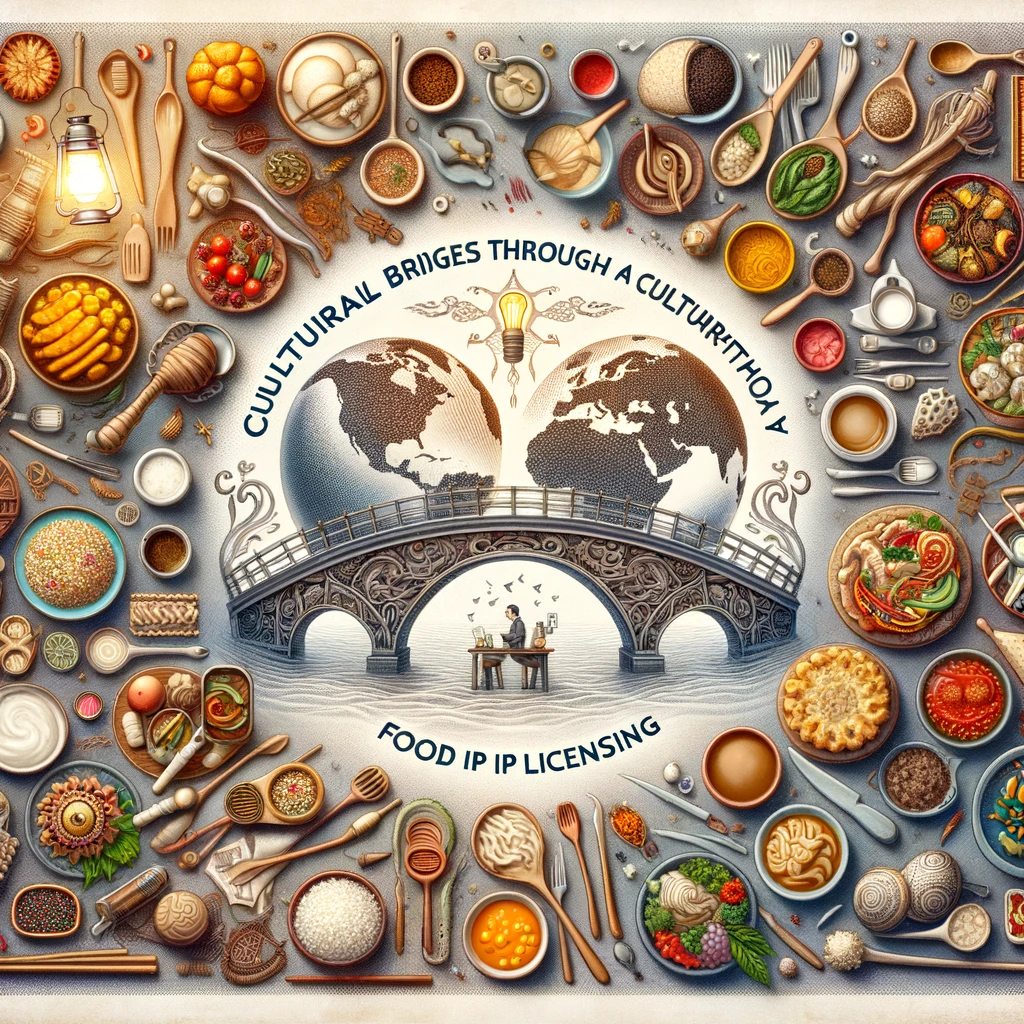In an era where the world is more connected than ever, the culinary industry stands out as a vibrant arena of cultural exchange and innovation. Central to this dynamic landscape is the concept of Food Intellectual Property (IP) Licensing, a legal framework that has become increasingly crucial in preserving, sharing, and innovating culinary traditions across continents. “Culinary Innovation Across Continents” delves into the intricate world of Food IP Licensing, unraveling its significant role in shaping the global culinary scene.
From the aromatic street foods of Asia to the rich, hearty flavors of European cuisine, every dish tells a story of culture, history, and human connection. As these diverse culinary traditions cross borders, Food IP Licensing ensures that the essence of these cultural heritages is respected, preserved, and celebrated globally. It’s not just about protecting recipes; it’s about honoring the legacy of generations and fostering a future of shared tastes and mutual respect.
This exploration begins with a glance at the roots of Food IP Licensing, tracing its evolution from a mere legal concept to a pivotal instrument in the global culinary market. Understanding this evolution provides a foundation for appreciating the complex processes involved in obtaining international IP licenses, highlighting the invaluable role of expert counsel in navigating this intricate landscape. Through real-world examples and case studies, we will witness the power of culinary exchange in bridging cultural divides, revealing how shared dining experiences can unite people from all walks of life.
However, this journey is not without its challenges. As we delve deeper into the economic impact and the innovative potential of Food IP Licensing, we also confront the hurdles it faces, including issues of authenticity and quality control. Finally, we cast our gaze forward, contemplating the future prospects of this fascinating field, pondering how it will continue to shape the bonds between cultures and the innovations in global cuisine.
As we embark on this culinary expedition, “Culinary Innovation Across Continents” invites readers to savor the rich tapestry of global cuisine, understanding how Food IP Licensing is not just a legal necessity, but a celebration of cultural diversity and culinary innovation.

Introduction to Food IP Licensing
In the tapestry of global cuisine, each dish not only offers a unique taste but also embodies a legacy of cultural heritage and tradition. At the heart of protecting and sharing these culinary treasures lies the concept of Food Intellectual Property (IP) Licensing. This legal framework plays a pivotal role in the culinary world, safeguarding recipes, cooking techniques, and even the very names of iconic dishes, thus preserving the authenticity and integrity of cuisines worldwide.
Food IP Licensing refers to the legal process wherein the creators or owners of a culinary product or technique grant permission to others to use their creation under agreed terms. This can include patents for innovative cooking methods, trademarks for distinctive food names, or copyrights for unique recipes. The primary aim is to protect the creator’s rights while allowing for the controlled dissemination and commercialization of their culinary innovation.
This form of licensing serves as a cornerstone for culinary artists, chefs, and food companies, ensuring that their creativity and hard work are rightfully recognized and rewarded. It empowers creators to share their culinary inventions with the world while providing a legal safeguard against unauthorized use or duplication. For consumers, this translates into an assurance of authenticity and quality, knowing that the dish they savor is a genuine representation of its cultural roots.
Moreover, Food IP Licensing is instrumental in fostering a climate of innovation in the culinary field. By protecting their intellectual property, creators are encouraged to experiment and innovate, knowing that their unique contributions to the culinary world will be protected. This not only enriches the global food scene with constant innovation but also paves the way for traditional recipes to find new life and relevance in the modern world.
In essence, Food IP Licensing is not merely a legal necessity; it is a celebration of culinary artistry and heritage. It is a testament to the respect and recognition that every creator’s contribution deserves, ensuring that the rich diversity of global cuisine continues to thrive and inspire.

Historical Context and Evolution
The journey of Food IP Licensing is as rich and diverse as the culinary traditions it seeks to protect. Tracing its roots back, this concept has evolved significantly, adapting to the ever-changing landscape of the global food industry.
Historically, the protection of culinary creations wasn’t as structured or universally recognized as it is today. Family recipes were passed down through generations, and local eateries made a name for themselves through signature dishes. However, the legal framework to protect these unique culinary creations was minimal. As globalization took hold, the need to safeguard culinary innovation became increasingly evident. The culinary world realized that recipes and cooking techniques, like any other form of art or invention, deserved legal protection and recognition.
The breakthrough came with the recognition of the unique value and identity that specific dishes and culinary techniques hold. Countries started acknowledging that their culinary heritage was not just a matter of national pride but also an invaluable asset that could contribute significantly to their cultural and economic landscape. This acknowledgment paved the way for more structured and robust IP laws, specifically catering to the culinary industry.
The evolution of Food IP Licensing is marked by several key milestones. The extension of copyright laws to cover recipes, the recognition of trademarks for specific dish names or restaurant branding, and the patenting of unique cooking techniques or apparatus – all these were monumental steps in transforming how culinary innovation is perceived and protected.
Today, Food IP Licensing stands as a testament to the rich history of culinary innovation and the forward-looking vision of preserving this heritage. It’s a dynamic field, constantly adapting to new trends, technologies, and market demands. The evolution from simple recipe sharing to structured IP licensing reflects a broader shift in recognizing and valuing the artistry and innovation inherent in the culinary world.
As we continue to explore the multifaceted world of Food IP Licensing, it’s essential to acknowledge this historical journey, for it shapes the current practices and future prospects of this fascinating intersection between law, culture, and cuisine.

The Process of Obtaining International IP Licenses
Navigating the waters of international Food IP Licensing is a complex and nuanced journey, often requiring meticulous attention to detail and a deep understanding of multifaceted legal frameworks. This process is not just about protecting a recipe or a culinary technique; it’s about strategically positioning one’s culinary creations in the global market while respecting and adhering to international laws and cultural sensitivities.
- Understanding the Legal Landscape: The first step in obtaining an international IP license is to understand the legal landscape of the target market. Laws and regulations regarding food IP can vary significantly from country to country. For instance, what’s patentable in one nation might not be in another. This makes it crucial for businesses or individuals to conduct thorough research or seek expert advice to navigate these differences.
- Identifying the Right Type of Protection: Depending on the nature of the culinary creation, different types of IP protection may be applicable. This could be a patent for a unique food processing technique, a trademark for a distinctive dish name, or even a copyright for a specialized recipe. Selecting the right type of IP protection is pivotal in safeguarding one’s culinary innovations effectively.
- Application and Registration Process: Once the appropriate type of IP protection is identified, the next step involves the actual application and registration process. This typically involves preparing and submitting detailed documentation that demonstrates the uniqueness and originality of the culinary creation, along with any necessary legal forms or fees.
- Navigating International Regulations: For international IP licensing, one must also consider international treaties and agreements, such as the Madrid Protocol for trademarks or the Patent Cooperation Treaty (PCT) for patents. Understanding and leveraging these agreements can streamline the process of securing IP protection across multiple countries.
- The Role of Expert Counsel: Given the complexity and country-specific nuances of international IP laws, seeking expert counsel is not just advisable; it’s often indispensable. Expert attorneys or IP consultants can provide invaluable guidance, ensuring that the application process is handled correctly and efficiently. They can also offer strategic advice on managing and enforcing IP rights, helping to maximize the value and impact of a culinary creation globally.
The journey of securing international IP licenses is intricate and challenging, but with the right approach and expert guidance, it can open doors to unprecedented opportunities in the global culinary marketplace. It’s a testament to the fact that in the world of culinary arts, innovation knows no boundaries, and with the right protection and strategy, culinary creations can transcend their local origins to be celebrated and savored worldwide.

Cultural Bridges through Culinary Exchange
In the intricate web of global interactions, food stands as a universal language, transcending linguistic barriers and cultural divides. Food IP Licensing plays a pivotal role in this cultural symphony, not just by protecting culinary creations but also by facilitating a rich exchange of culinary traditions across the globe.
- Showcasing Cultural Heritage: Every cuisine tells a story of a community’s history, environment, and traditions. Food IP Licensing allows these stories to be shared and celebrated on a global stage. By protecting the authenticity of these dishes, it ensures that the cultural heritage is preserved and respected when introduced to new markets. This fosters a deeper appreciation and understanding of diverse culinary traditions worldwide.
- Fusion and Innovation: As cuisines travel beyond their local boundaries, they often intertwine with other culinary traditions, giving rise to innovative fusion dishes. Food IP Licensing ensures that these new creations are appropriately attributed and protected, encouraging chefs and food innovators to explore and experiment with confidence, knowing their intellectual property is secure.
- Economic Empowerment through Cuisine: Traditional recipes and culinary techniques can be valuable economic assets for local communities. Food IP Licensing empowers these communities by providing the tools to protect and commercialize their culinary heritage. This not only contributes to local economies but also enhances the global market by introducing authentic and diverse culinary experiences.
- Education and Awareness: The journey of a dish from its origin to a foreign table is laden with stories and knowledge. Food IP Licensing helps in preserving the educational value of culinary traditions, ensuring that the origins, ingredients, and cultural significance are accurately conveyed. This promotes a global culture of culinary literacy and respect for diverse food heritages.
- Building Global Networks: Food IP Licensing establishes a structured platform for culinary professionals, businesses, and enthusiasts to connect, collaborate, and create. This network transcends geographical limitations, creating a global community united by a shared passion for culinary arts and innovation.
Through these avenues, Food IP Licensing doesn’t just protect; it connects. It builds bridges between cultures, inviting people to explore, understand, and celebrate the diversity of global cuisines. It’s a testament to the power of food as a catalyst for cultural exchange and mutual respect.

Economic and Innovation Impact
The realm of Food IP Licensing is not only a cultural cornerstone but also a significant economic catalyst and a hotbed for innovation. Its influence extends beyond the protection of recipes and culinary techniques, playing a pivotal role in shaping the economic landscape of the culinary industry and driving relentless innovation in global cuisine.
- Stimulating Economic Growth: Food IP Licensing is a key driver of economic growth in the culinary sector. By providing a framework for protecting and commercializing culinary creations, it encourages investment in the food industry, from local artisanal producers to global food corporations. This, in turn, contributes to job creation, boosts local economies, and stimulates global trade.
- Encouraging Entrepreneurship and Small Businesses: The protection offered by Food IP Licensing levels the playing field, allowing small-scale chefs, innovators, and food entrepreneurs to compete with larger entities. It empowers them to bring their unique culinary products to market, secure in the knowledge that their intellectual property is protected.
- Fostering Innovation and Creativity: The assurance of IP protection serves as a strong incentive for continuous innovation in the culinary world. Chefs, food scientists, and innovators are encouraged to push boundaries and experiment, knowing that their creative culinary concepts will be legally safeguarded. This not only leads to a diverse and vibrant culinary landscape but also to the advancement of food technology and preparation techniques.
- Enhancing Consumer Trust and Quality: Food IP Licensing contributes to maintaining high standards of quality and authenticity in the food industry. It assures consumers that the culinary products they purchase are genuine, meet safety standards, and are produced ethically. This trust is crucial in today’s globally connected marketplace, where consumers are increasingly conscious of the origin and quality of their food.
- Globalization of Local Cuisines: The structured approach to protecting and licensing culinary creations has facilitated the globalization of local cuisines. Dishes that were once confined to specific regions are now enjoyed worldwide, not merely as exotic delicacies but as integral components of the global culinary scene. This not only enriches the global food palette but also fosters a deeper, more inclusive understanding of different cultures.
Food IP Licensing thus serves as a crucial bridge between tradition and modernity, local and global, fostering a dynamic and interconnected culinary landscape. It’s a testament to the power of legal frameworks to not only protect but also to nurture and proliferate the rich tapestry of global cuisine.

Challenges and Future Prospects
As we delve into the intricacies of Food IP Licensing, it’s crucial to acknowledge the challenges this field faces while also casting an optimistic gaze at its future prospects. This journey, while rich in opportunities, is not devoid of hurdles, and understanding these challenges is key to harnessing the full potential of Food IP Licensing in the global culinary landscape.
- Maintaining Authenticity and Quality: One of the most significant challenges in Food IP Licensing is ensuring the authenticity and quality of culinary products as they transcend cultural and geographical boundaries. As dishes and culinary techniques become global, maintaining the original essence and quality can be daunting. This requires stringent quality control measures and a robust legal framework to combat imitations and uphold standards.
- Navigating Complex Legal Landscapes: The legal intricacies of IP licensing, especially on an international scale, pose a substantial challenge. Differences in IP laws across countries, coupled with the complexities of enforcing these rights in foreign territories, make it crucial for culinary innovators to seek expert legal counsel and be well-versed in the nuances of international IP regulations.
- Balancing Commercialization and Cultural Sensitivity: As culinary creations become commercialized, striking a balance between profitability and cultural sensitivity becomes paramount. It’s essential to respect and honor the cultural heritage that each dish represents, ensuring that commercialization does not lead to cultural appropriation or misrepresentation.
Looking ahead, the future of Food IP Licensing is bright and promising, teeming with opportunities for growth and innovation.
- Embracing Technological Advancements: The integration of technology in the culinary world, from blockchain for traceability to AI in culinary innovation, presents exciting prospects for Food IP Licensing. These technologies can offer more robust protection, streamline the licensing process, and open new avenues for culinary creativity and distribution.
- Fostering Global Collaboration: The future holds immense potential for global collaboration in the culinary sector. Food IP Licensing can act as a catalyst, bringing together culinary experts, innovators, and entrepreneurs from across the world to collaborate, innovate, and create new culinary experiences.
- Promoting Sustainability and Ethical Practices: As global awareness of sustainability and ethical practices grows, Food IP Licensing can play a pivotal role in promoting these values. By protecting and promoting culinary innovations that prioritize sustainability and ethics, the culinary world can contribute to a more responsible and conscientious global food culture.
In conclusion, while Food IP Licensing faces its share of challenges, its future is replete with possibilities. By addressing these challenges head-on and harnessing the opportunities that lie ahead, Food IP Licensing can continue to be a powerful force in shaping a rich, diverse, and innovative global culinary landscape.

Conclusion
As we’ve journeyed through the multifaceted world of Food IP Licensing, we’ve uncovered its profound impact on the global culinary landscape. From its roots in protecting culinary innovations to its role in fostering cultural exchange and economic growth, Food IP Licensing has proven to be an indispensable element in the world of gastronomy.
We’ve seen how it safeguards the heritage and authenticity of traditional cuisines while opening doors for innovation and creativity. It’s a testament to the delicate balance between preserving culinary legacies and embracing the new, between respecting tradition and nurturing progress.
The challenges that lie ahead are real and substantial, from navigating complex legal landscapes to ensuring that commercialization doesn’t overshadow cultural sensitivity. Yet, the future is bright with possibilities, promising a world where culinary artistry is protected, shared, and celebrated across borders.
In this global dance of flavors, aromas, and textures, Food IP Licensing is not just a legal framework; it’s the rhythm that harmonizes diverse culinary traditions, ensuring that every note, every spice, and every recipe is a tribute to the universal language of food.
As we continue to savor the richness of global cuisines, let’s embrace the role of Food IP Licensing in crafting a future where culinary innovation knows no boundaries, where every dish tells a story of culture, innovation, and shared human experience.
